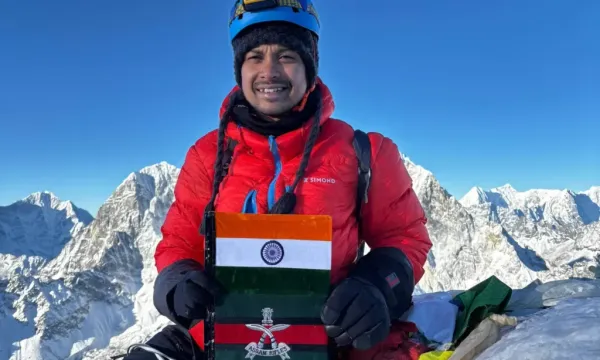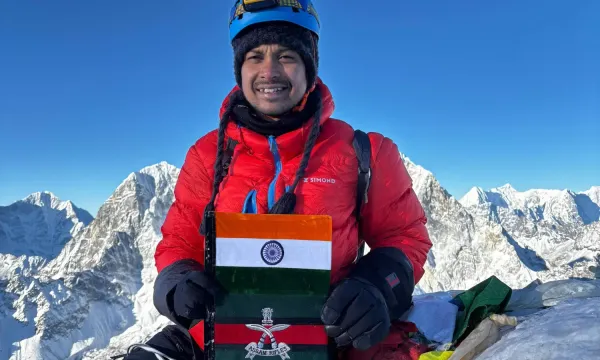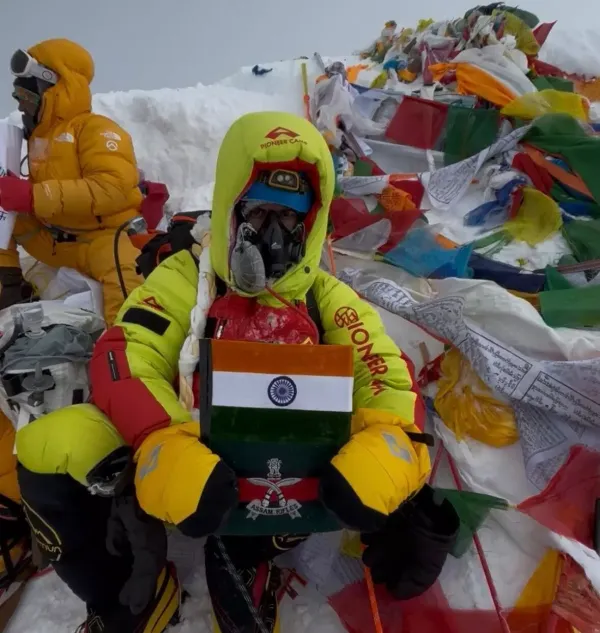


“On May 19, 7:30am (Nepal Time) I was on top of the world and it felt surreal,” an elated Aritra Roy said.
In a remarkable feat of determination, endurance and resilience, Aritra Roy’s adventurous journey from Ujjayanta Palace in Agartala to the top of the world – Mount Everest – went down in history. The 35-year-old became first from Tripura to summit the world’s highest peak.
Roy embarked on two and a half month long multi-sport adventure and this feat which was curated as a triathlon involving cycling, climbing and running is a first of its kind expedition in India.
The adventure commenced on March 16 with pedaling along with members of the Tripura Cycling Explorers for about 80kms. Roy traversed the remaining 1300kms in 21 days to reach Phalphu.
Phalphu, a mountainous town in eastern Nepal at 7,917 feet, is a popular starting point for treks to the Everest and Dudh Kunda regions.
He then set out on his path to the Everest Base Camp (EBC) with the Glacier Himalaya Treks and Expedition on April 7, ascending around 1,000ft everyday.
Challenging terrain
He faced challenges of treacherous mountain paths and deep valleys, but Roy kept treading and passed through some key points like Dingboche (4,410m), completed his mandatory acclimatisation peak summit rotation to Nagarjuna Peak (5,083m), Mount Lobuche (6,119m), and finally reaching the EBC (5,364m) on April 20.
“The landscape till 10,000ft was green, filled with streams, waterfalls but it turned barren with high-altitude desert as we ascended,” said Roy.
The next 10 days at the EBC, from April 20-30, were dedicated to ice training, jumaring or ascending with rope. In climbing, jumar is a device used by climbers to ascend using a fixed rope.
The ascend to camp 1, as part of second acclimatisation rotation, required traversing the treacherous Khumbu Icefall. The ever-changing landscape, melting ice made the trek critical and dangerous.
“The route to Mt Everest was open on May 9 but we had to wait for a favourable weather window. On May 15, the real journey began. Karma Sherpa, my personal sherpa, and I pushed through treacherous mountain paths, rocky trails, thinning oxygen levels and an ever challenging landscape,” he added.
Unpredictable weather
High altitude, harsh and unpredictable weather conditions make the stretch strenuous and difficult to summit.
“Up until Camp 3, I did not use my oxygen. At camp 4, I could still see a huge peak in front of me and I told myself ‘I have climbed 8,000m. How will I do it?’”

Aritra holding the Indian flag at the summit of Mt. Everest
“When I reached Hillary step, I couldn’t believe I was just 100m away from my destination. I had my share of emotions. I stood there (at the top) for 30 minutes, soaked in the moment. The weather changed drastically and it started to get windy and frightening. I event had an ice blast on my left cheek, a frost bite,” Roy shared.
Hillary Step can be a tricky zone, with an extremely narrow path that gets technically demanding and making it a bottleneck for climbers. It is considered the last real challenge before reaching the summit.
Self confidence
“In high altitudes its important to keep the mind calm even though there are so many distractions in the surrounding. To keep your morale up even when you see dead bodies and hear news about fellow climbers dying,” he said.
The expedition of scaling Mt Everest was followed by a 42 km marathon, which Roy completed in a little over 8 hours, on International Everest Day, on May 29.
The adventurous exploration culminated on June 1, proving out to be a journey of grit, determination and an undying spirit to finish what Roy started.